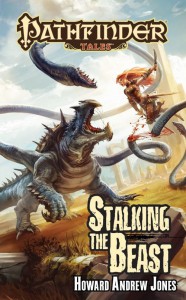Outlining, Part 2
 Back in August of 2013 I discussed my new outlining approach in depth. At the time I wasn’t sure how useful I’d find it in the long run, but it seemed to be working very well. Here’s the whole article if you want a quick refresher, because it’s turned out to work even better than I might have hoped.
Back in August of 2013 I discussed my new outlining approach in depth. At the time I wasn’t sure how useful I’d find it in the long run, but it seemed to be working very well. Here’s the whole article if you want a quick refresher, because it’s turned out to work even better than I might have hoped.
What it boils down to is two main points.
1. Draft a super detailed outline that may range into the tens of thousands of words for the book.
2. Once that’s in hand, begin your drafting almost like a loose play, sort of a “stagey outline.” It includes snatches of dialogue, bits of scenery description, and notes to yourself about when some element or creature or piece of information was introduced.
I’ve used that method now for Stalking the Beast and for the first novel of my new epic sword-and-sorcery series, and now I’m using it for my third Pathfinder novel… and by God, it works. It works so well that by a second read pass most of the adjustments I have to make are small ones.
Moreover, my daily rough draft word count has pretty much doubled. It’s not just that this new method works so well for me that I’m backtracking less and writing fewer scenes that I end up scrapping, it’s that I’m now routinely drafting over 4k a day. (Well, on days when the kids aren’t snowed out of school, or have two hour delays, or things like that.) Sure, it’s rough, but as my friend E.E. Knight says, give yourself permission to write badly on that rough draft. The next two passes are for making it pretty, and clear.
 And something I’ve taken from a conversation with Scott Lynch about the way he works is to feel free to bounce all over the narrative. Once I have some of the parts down, I might go back and polish, say, chapter 2 a little more, then work on rough drafting chapter 15, then work on a related character arc back in chapter 13. Because I’m no longer tied to making it all get smooth in the proper order or being anal retentive about trying to make it all work perfectly the first time through, the work is getting stronger, faster.
And something I’ve taken from a conversation with Scott Lynch about the way he works is to feel free to bounce all over the narrative. Once I have some of the parts down, I might go back and polish, say, chapter 2 a little more, then work on rough drafting chapter 15, then work on a related character arc back in chapter 13. Because I’m no longer tied to making it all get smooth in the proper order or being anal retentive about trying to make it all work perfectly the first time through, the work is getting stronger, faster.
I’m not fool enough to believe that this is all happening because I’ve finally found the perfect system. I’m not tearing out my hair and saying “Why, oh why didn’t I figure this out before?” I know a lot of the reason this works NOW is because I’ve finally got my feet under me and know some instinctive things about pacing and plotting and how many characters are required for a scene and when conflict is necessary and a whole bunch of other stuff. I’ve written enough long works that some of the process is getting instinctive. My guess is that it wouldn’t have worked as well for me in the past.
As I wrote the last time I discussed outlining, dialogue always comes fairly easily for me, and dialogue is the lynch pin of this method. If the dialogue isn’t sounding right as I’m doing the “stagey outline” then I just keep massaging it until it does, without having to worry about having wasted tons of effort on description I won’t need anymore.
I should also say, though, that this method wouldn’t work if I didn’t know who my characters were. Because these characters are like a second skin to me the conversations flow fairly easily.
Your own mileage with this system may vary, depending upon your own strengths (I’m not sure how well it would work for someone who struggles with dialogue), but I offer it up in the hopes you’ll find something useful from my own experience.
0 Comments